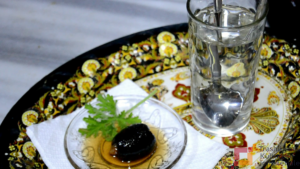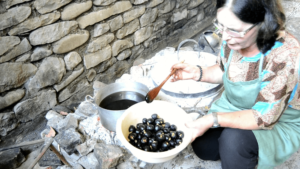The small city of Permet is home to gliko – one of its immense cuisine treasures. It is a sweet spoon preserve made from various locally grown fruits and vegetables.
Walnut gliko, made from whole unripe green walnuts, is one of the most popular glikos, others can be made from cherry, eggplant, wild fig, plum, tomato, carrot, etc. Walnut gliko prepared from fresh unripe green walnuts, as otherwise known kaçka, must be harvested at an appropriate period.
Harvesting of unripe green walnuts for gliko.
The unripe green walnuts are typically harvested from 1 to 15 June. After this step, unripe green walnuts are tested to check whether they have mildew by squeezing the tip of the knife on top of them in a V-shape and pricking on both sides with an awl (metal rod). After making sure that no mildew has grown in unripe green walnuts, they are collected at an adequate amount, cut on top and bottom in a V-shape, and once pricked with an awl, they are soaked into a pot to boil. As soon as this step is over, unripe green walnuts are placed in a container of fresh water to stay still for 40 consecutive days, changing the water twice a day. After 40 days, unripe green walnuts are tested by hand to see whether the outer layer is removed; if so, they are cleaned off and dipped into a container of clean water to give a rinse two or three times. In the meantime, a container of lime juice is prepared to prepare the place where the unripe green walnuts are soaked in and let sit for about two hours.
Preparation for boiling process.
After taking unripe green walnuts from the lime juice, they are boiled and then left to cool. After 24 hours, they are again boiled and then removed from the heat.
Preparation of sugar-water syrup.
A number of 25 unripe green walnuts are counted for 1 kg of sugar and 3 glasses of water, which are put on the stovetop. Once this mixture starts to boil, the foam must be skimmed off from the surface every few minutes as it contains particles or debris and makes the syrup cloudy. Let it cook for a while until the sap thickens. With a slotted spoon, the walnuts are strained from the sap, filled with walnut or almond kernels, and poured back into the syrup. If, by testing a little sap on the index fingernail a bead-like drop remains, the syrup must thereupon be removed from the heat. Before doing this, a spoonful of citric acid or sour salt and some aromatic leaves from the geranium plant need to be added. Once removed from the heat, the mixture is left to cool and placed into jars that are tightly sealed and stored in cool and dry places









